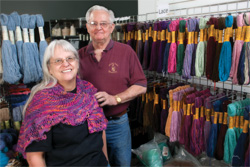ALBUQUERQUE, N.M. — Rod Dakan, owner of Royal Fiber Spinnery in Ruidoso, N.M., wanted an economical method of baling fleece from small, scattered alpaca herds for transport to the mills, so he turned to the New Mexico Small Business Assistance (NMSBA) Program for help.
Royal Fiber was one of 339 small businesses in 27 counties that participated in 2010 in the NMSBA Program, a public-private partnership among Sandia National Laboratories, Los Alamos National Laboratory and the state of New Mexico that connects small business owners with scientists and engineers who provide assistance to their companies. The program provided $4.6 million worth of technical assistance to small businesses last year.
Ten projects that achieved outstanding innovations through the NMSBA Program in 2010 are being honored today at a 10 Years of Innovation Celebration in Albuquerque. The program also marked its 10th anniversary by including small business owners it has helped since its inception.
“The NMSBA Program has been bringing together small business owners with world-class scientists, engineers and other experts at Sandia and Los Alamos national laboratories and other partner organizations for more than 10 years. These partnerships have not only resulted in the successful innovations we’ve celebrated over the past decade, but also have brought jobs and economic growth to our state,” said Jackie Kerby Moore, manager of Sandia’s Technology & Economic Development Department.
Royal Fiber, the largest alpaca fiber processor in the country, spins on average 12,000 pounds of fleece into yarn every year, Dakan said. Yet, because alpacas are raised in scattered herds of 20 animals or less, traditional 700-pound wool and cotton balers aren’t an effective way to package and ship the fiber to processors like Royal Fiber.
Through the NMSBA Program, Dakan met Bob Winters, who retired last year from the Organic Materials Department’s Manufacturing Science and Technology Group at Sandia. They discussed how to design a baler that could pack 50-70 pounds of fleece into a 1.5-foot square box suitable for shipping.
Winters, who has provided his design expertise to several successful NMSBA projects, said he tried a manual press to bale the fleece, but it broke the box the fiber was to be shipped in, so he switched to a hydraulic press. He also used a machine in the lab that applied 5,000 pounds of force to compress small amounts of alpaca fleece to prove that his concept worked.
In an animation of the design, the shipping box is inserted under a chute. The alpaca fiber comes down the chute, is compressed into the box, and a fork holds it in place as the ram retracts. If more fiber is added, the fork retracts as the fiber is being compressed.
Winters provided Dakan with a detailed design, a 3-D model and specifications for parts, materials and welding instructions, which Dakan can use to have a prototype built, a project Dakan said he’s pursuing.
Dakan said he wants to expand his business to include selling balers to alpaca farmers. He also hopes the baler can one day increase the domestic market for alpaca fleece, which wicks 80 percent better than wool and is three times warmer.
Small business owners have big ideas, but often are short on money to pursue them, so they need programs custom designed for them, Dakan said. “This program in that regard is awesome,” he said. “Their attitude is ‘Tell us what the problem is and let’s see if we can fix it.’ That’s the kind of thing that made this country great in the first place.”
Here is a selection of additional projects that will be recognized today:
- Pesticide Application Technologies’ research director Ellis Huddleston, an emeritus professor at New Mexico State University, wanted to design a pesticide sprayer that could decrease the number of disease-carrying mosquitoes in the developing world. Huddleston found current equipment was ineffective, so he sought help from two researchers with Sandia’s Fire & Aerosol Sciences group, John Brockmann and Daniel Lucero. Now, Huddleston has a blueprint for a small, hand-held pesticide sprayer and data to prove the concept, which will enable him to get the technology to where it’s needed.
- Santa Cruz reservoir supplies water to about 1,600 farms in the Espanola Valley, but sediment reduced the reservoir’s capacity by 36 percent, hurting small businesses like Kenny Salazar Orchards, which irrigates with reservoir water. Sandia and Los Alamos researchers uncovered the sources of the sediment and recommended solutions. Their findings saved the Santa Cruz Irrigation District from building an expensive sediment trap in the wrong location and showed them where to place lower-cost sediment traps.
- Albuquerque companies Vibrant Corp., Mechtronic Solutions Inc., Fiore Industries Inc. and ZTEC Instruments Inc. asked the NMSBA Program to help evaluate Process Compensated Resonance Testing (PCRT) of aviation components. Sandia’s Airworthiness Assurance Non-Destructive Inspection Validation Center used good and bad airplane engine turbine blades to compare standard structural testing methods to PCRT, a nondestructive technology that provides cost-effective and fast reporting on the structural integrity of components. Since working with Sandia, Vibrant has earned Federal Aviation Administration approval to use PCRT, which increased business opportunities and contacts for the other partner companies, as well as substantial cost savings for the aviation industry.
More detailed information on all 10 award winners is available upon request.
Since its inception, the NMSBA Program has provided 1,736 small businesses with $25.2 million worth of research hours and materials. The program has helped create and retain nearly 1,550 New Mexico jobs at an average salary of about $38,000, increase small companies’ revenues by $82 million and decrease their operating costs by $45 million. These companies have invested $19 million in other New Mexico goods and services.
For further information about the NMSBA Program, entrepreneurs may call Genaro Montoya at (505) 284-0625 or visit http://www.nmsbaprogram.org.

